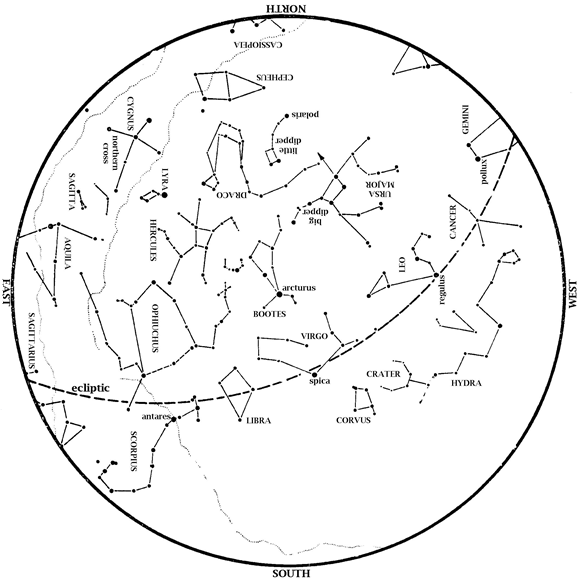Editor’s Note: Summer Solstice is upon us this month and HMNS Astronomer James Wooten points to the Sun’s highest point in our sky.
Saturn is in the southeast at dawn.
Mars is also in the morning sky, in the east at dawn. Mars and Saturn easily outshine the very dim stars around them.
Venus is lost in the Sun’s glare and out of sight this month. In fact, it is directly behind the Sun, meaning that the Sun’s disk literally blocks Venus, from 12:30 on June 3 to 9:10 on June 5.
Jupiter begins to emerge from the Sun’s glare this month. Look west northwest as twilight begins. By the 30th, Jupiter is high in the sky at dawn and easy to see.
On the morning of June 4, Mercury is less than seven arcminutes (60 arcminutes = one degree) from Jupiter. Alas, the pair of planets appears only about 12 degrees away from the Sun and does not rise until deep twilight. If you’re able to see Mercury and Jupiter, they complete a parade of six planets in the morning sky—all except Earth (where you’re standing) and Venus, which is behind the Sun. However, only Saturn and Mars are easy to see. Neptune is about 11 degrees east (left from our perspective) of Saturn, while Uranus is between the crescent Moon and the Jupiter/Mercury pair. Both of those, though require binoculars or a telescope to observe, especially in twilight.
Spring stars are high in the south and west. A distinct backwards question mark shape outlines the mane and forepaws of Leo, the Lion. Three stars forming a right triangle are to its upper left; they mark Leo’s hindquarters. The Big Dipper is as high as it ever gets in the north at dusk. You can extend the curve of its handle to ‘arc to Arcturus’ and then ‘speed on to Spica’. These stars high in the east and south, respectively, by dusk tonight. Arcturus, by the way, is the fourth brightest star we ever see at night, but the brightest one Americans ever see in all of June and July.
In the east, look for the enormous Summer Triangle, consisting of the stars Deneb, Vega, and Altair. This triangle is up all night long from mid-June to mid-August, hence its name. Scorpius, the Scorpion, is in the southeast at dusk. Sagittarius, the Archer, known for its ‘teapot’ asterism, rises just after dusk on June 1, but is up by nightfall on June 30.

The Big Dipper is high in the north. From the Big Dipper’s handle, arc to Arcturus and then speed on to Spica in the south. Cygnus, Lyra, and Aquila form the Summer Triangle in the east, as Scorpius and Sagittarius rise in the southeast. Summer has arrived.
Moon Phases in June 2024
New June 6, 7:38 a.m.
1st Quarter June 13, 12:18 a.m.
Full June 21, 8:08 p.m.
Last Quarter June 28, 4:53 pm
At 3:51 pm on Thursday, June 20, the Sun is directly overhead as seen from the Tropic of Cancer. This means that Earth’s north pole is tilted as much as possible towards the Sun, making this our summer solstice. On this date the midday Sun is as high as possible in our sky—virtually overhead—and we have more daylight than on any other day of the year. Below the equator, the opposite is true. There, the midday Sun is as low as possible in the sky, and there is less daylight than on any other day of the year. For them, June 20 is the winter solstice.
Our George Observatory is now open every Saturday night for observing! Purchase tickets in advance on our website.
Clear Skies!
Looking for May’s sky happenings? Check them out here.






